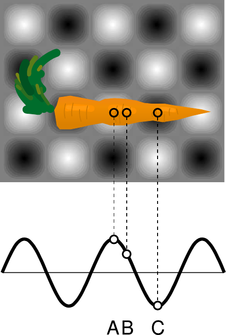14.2: Light As a Particle
- Page ID
- 987
\( \newcommand{\vecs}[1]{\overset { \scriptstyle \rightharpoonup} {\mathbf{#1}} } \)
\( \newcommand{\vecd}[1]{\overset{-\!-\!\rightharpoonup}{\vphantom{a}\smash {#1}}} \)
\( \newcommand{\dsum}{\displaystyle\sum\limits} \)
\( \newcommand{\dint}{\displaystyle\int\limits} \)
\( \newcommand{\dlim}{\displaystyle\lim\limits} \)
\( \newcommand{\id}{\mathrm{id}}\) \( \newcommand{\Span}{\mathrm{span}}\)
( \newcommand{\kernel}{\mathrm{null}\,}\) \( \newcommand{\range}{\mathrm{range}\,}\)
\( \newcommand{\RealPart}{\mathrm{Re}}\) \( \newcommand{\ImaginaryPart}{\mathrm{Im}}\)
\( \newcommand{\Argument}{\mathrm{Arg}}\) \( \newcommand{\norm}[1]{\| #1 \|}\)
\( \newcommand{\inner}[2]{\langle #1, #2 \rangle}\)
\( \newcommand{\Span}{\mathrm{span}}\)
\( \newcommand{\id}{\mathrm{id}}\)
\( \newcommand{\Span}{\mathrm{span}}\)
\( \newcommand{\kernel}{\mathrm{null}\,}\)
\( \newcommand{\range}{\mathrm{range}\,}\)
\( \newcommand{\RealPart}{\mathrm{Re}}\)
\( \newcommand{\ImaginaryPart}{\mathrm{Im}}\)
\( \newcommand{\Argument}{\mathrm{Arg}}\)
\( \newcommand{\norm}[1]{\| #1 \|}\)
\( \newcommand{\inner}[2]{\langle #1, #2 \rangle}\)
\( \newcommand{\Span}{\mathrm{span}}\) \( \newcommand{\AA}{\unicode[.8,0]{x212B}}\)
\( \newcommand{\vectorA}[1]{\vec{#1}} % arrow\)
\( \newcommand{\vectorAt}[1]{\vec{\text{#1}}} % arrow\)
\( \newcommand{\vectorB}[1]{\overset { \scriptstyle \rightharpoonup} {\mathbf{#1}} } \)
\( \newcommand{\vectorC}[1]{\textbf{#1}} \)
\( \newcommand{\vectorD}[1]{\overrightarrow{#1}} \)
\( \newcommand{\vectorDt}[1]{\overrightarrow{\text{#1}}} \)
\( \newcommand{\vectE}[1]{\overset{-\!-\!\rightharpoonup}{\vphantom{a}\smash{\mathbf {#1}}}} \)
\( \newcommand{\vecs}[1]{\overset { \scriptstyle \rightharpoonup} {\mathbf{#1}} } \)
\( \newcommand{\vecd}[1]{\overset{-\!-\!\rightharpoonup}{\vphantom{a}\smash {#1}}} \)
\(\newcommand{\avec}{\mathbf a}\) \(\newcommand{\bvec}{\mathbf b}\) \(\newcommand{\cvec}{\mathbf c}\) \(\newcommand{\dvec}{\mathbf d}\) \(\newcommand{\dtil}{\widetilde{\mathbf d}}\) \(\newcommand{\evec}{\mathbf e}\) \(\newcommand{\fvec}{\mathbf f}\) \(\newcommand{\nvec}{\mathbf n}\) \(\newcommand{\pvec}{\mathbf p}\) \(\newcommand{\qvec}{\mathbf q}\) \(\newcommand{\svec}{\mathbf s}\) \(\newcommand{\tvec}{\mathbf t}\) \(\newcommand{\uvec}{\mathbf u}\) \(\newcommand{\vvec}{\mathbf v}\) \(\newcommand{\wvec}{\mathbf w}\) \(\newcommand{\xvec}{\mathbf x}\) \(\newcommand{\yvec}{\mathbf y}\) \(\newcommand{\zvec}{\mathbf z}\) \(\newcommand{\rvec}{\mathbf r}\) \(\newcommand{\mvec}{\mathbf m}\) \(\newcommand{\zerovec}{\mathbf 0}\) \(\newcommand{\onevec}{\mathbf 1}\) \(\newcommand{\real}{\mathbb R}\) \(\newcommand{\twovec}[2]{\left[\begin{array}{r}#1 \\ #2 \end{array}\right]}\) \(\newcommand{\ctwovec}[2]{\left[\begin{array}{c}#1 \\ #2 \end{array}\right]}\) \(\newcommand{\threevec}[3]{\left[\begin{array}{r}#1 \\ #2 \\ #3 \end{array}\right]}\) \(\newcommand{\cthreevec}[3]{\left[\begin{array}{c}#1 \\ #2 \\ #3 \end{array}\right]}\) \(\newcommand{\fourvec}[4]{\left[\begin{array}{r}#1 \\ #2 \\ #3 \\ #4 \end{array}\right]}\) \(\newcommand{\cfourvec}[4]{\left[\begin{array}{c}#1 \\ #2 \\ #3 \\ #4 \end{array}\right]}\) \(\newcommand{\fivevec}[5]{\left[\begin{array}{r}#1 \\ #2 \\ #3 \\ #4 \\ #5 \\ \end{array}\right]}\) \(\newcommand{\cfivevec}[5]{\left[\begin{array}{c}#1 \\ #2 \\ #3 \\ #4 \\ #5 \\ \end{array}\right]}\) \(\newcommand{\mattwo}[4]{\left[\begin{array}{rr}#1 \amp #2 \\ #3 \amp #4 \\ \end{array}\right]}\) \(\newcommand{\laspan}[1]{\text{Span}\{#1\}}\) \(\newcommand{\bcal}{\cal B}\) \(\newcommand{\ccal}{\cal C}\) \(\newcommand{\scal}{\cal S}\) \(\newcommand{\wcal}{\cal W}\) \(\newcommand{\ecal}{\cal E}\) \(\newcommand{\coords}[2]{\left\{#1\right\}_{#2}}\) \(\newcommand{\gray}[1]{\color{gray}{#1}}\) \(\newcommand{\lgray}[1]{\color{lightgray}{#1}}\) \(\newcommand{\rank}{\operatorname{rank}}\) \(\newcommand{\row}{\text{Row}}\) \(\newcommand{\col}{\text{Col}}\) \(\renewcommand{\row}{\text{Row}}\) \(\newcommand{\nul}{\text{Nul}}\) \(\newcommand{\var}{\text{Var}}\) \(\newcommand{\corr}{\text{corr}}\) \(\newcommand{\len}[1]{\left|#1\right|}\) \(\newcommand{\bbar}{\overline{\bvec}}\) \(\newcommand{\bhat}{\widehat{\bvec}}\) \(\newcommand{\bperp}{\bvec^\perp}\) \(\newcommand{\xhat}{\widehat{\xvec}}\) \(\newcommand{\vhat}{\widehat{\vvec}}\) \(\newcommand{\uhat}{\widehat{\uvec}}\) \(\newcommand{\what}{\widehat{\wvec}}\) \(\newcommand{\Sighat}{\widehat{\Sigma}}\) \(\newcommand{\lt}{<}\) \(\newcommand{\gt}{>}\) \(\newcommand{\amp}{&}\) \(\definecolor{fillinmathshade}{gray}{0.9}\)The only thing that interferes with my learning is my education. -- Albert Einstein
Radioactivity is random, but do the laws of physics exhibit randomness in other contexts besides radioactivity? Yes. Radioactive decay was just a good playpen to get us started with concepts of randomness, because all atoms of a given isotope are identical. By stocking the playpen with an unlimited supply of identical atom-toys, nature helped us to realize that their future behavior could be different regardless of their original identicality. We are now ready to leave the playpen, and see how randomness fits into the structure of physics at the most fundamental level.
The laws of physics describe light and matter, and the quantum revolution rewrote both descriptions. Radioactivity was a good example of matter's behaving in a way that was inconsistent with classical physics, but if we want to get under the hood and understand how nonclassical things happen, it will be easier to focus on light rather than matter. A radioactive atom such as uranium-235 is after all an extremely complex system, consisting of 92 protons, 143 neutrons, and 92 electrons. Light, however, can be a simple sine wave.
However successful the classical wave theory of light had been --- allowing the creation of radio and radar, for example --- it still failed to describe many important phenomena. An example that is currently of great interest is the way the ozone layer protects us from the dangerous short-wavelength ultraviolet part of the sun's spectrum. In the classical description, light is a wave. When a wave passes into and back out of a medium, its frequency is unchanged, and although its wavelength is altered while it is in the medium, it returns to its original value when the wave reemerges. Luckily for us, this is not at all what ultraviolet light does when it passes through the ozone layer, or the layer would offer no protection at all!
13.2.1 Evidence for light as a particle
For a long time, physicists tried to explain away the problems with the classical theory of light as arising from an imperfect understanding of atoms and the interaction of light with individual atoms and molecules. The ozone paradox, for example, could have been attributed to the incorrect assumption that one could think of the ozone layer as a smooth, continuous substance, when in reality it was made of individual ozone molecules. It wasn't until 1905 that Albert Einstein threw down the gauntlet, proposing that the problem had nothing to do with the details of light's interaction with atoms and everything to do with the fundamental nature of light itself.

a / Digital camera images of dimmer and dimmer sources of light. The dots are records of individual photons.
In those days the data were sketchy, the ideas vague, and the experiments difficult to interpret; it took a genius like Einstein to cut through the thicket of confusion and find a simple solution. Today, however, we can get right to the heart of the matter with a piece of ordinary consumer electronics, the digital camera. Instead of film, a digital camera has a computer chip with its surface divided up into a grid of light-sensitive squares, called “pixels.” Compared to a grain of the silver compound used to make regular photographic film, a digital camera pixel is activated by an amount of light energy orders of magnitude smaller. We can learn something new about light by using a digital camera to detect smaller and smaller amounts of light, as shown in figure a. Figure a/1 is fake, but a/2 and a/3 are real digital-camera images made by Prof. Lyman Page of Princeton University as a classroom demonstration. Figure a/1 is what we would see if we used the digital camera to take a picture of a fairly dim source of light. In figures a/2 and a/3, the intensity of the light was drastically reduced by inserting semitransparent absorbers like the tinted plastic used in sunglasses. Going from a/1 to a/2 to a/3, more and more light energy is being thrown away by the absorbers.
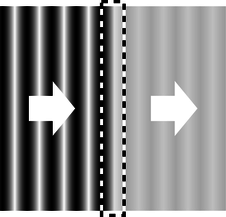
b / A wave is partially absorbed.
The results are drastically different from what we would expect based on the wave theory of light. If light was a wave and nothing but a wave, b, then the absorbers would simply cut down the wave's amplitude across the whole wavefront. The digital camera's entire chip would be illuminated uniformly, and weakening the wave with an absorber would just mean that every pixel would take a long time to soak up enough energy to register a signal.
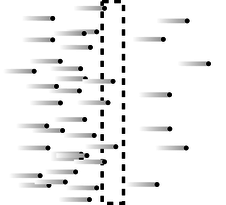
c / A stream of particles is partially absorbed.
But figures a/2 and a/3 show that some pixels take strong hits while others pick up no energy at all. Instead of the wave picture, the image that is naturally evoked by the data is something more like a hail of bullets from a machine gun, c. Each “bullet” of light apparently carries only a tiny amount of energy, which is why detecting them individually requires a sensitive digital camera rather than an eye or a piece of film.
Although Einstein was interpreting different observations, this is the conclusion he reached in his 1905 paper: that the pure wave theory of light is an oversimplification, and that the energy of a beam of light comes in finite chunks rather than being spread smoothly throughout a region of space.
We now think of these chunks as particles of light, and call them “photons,” although Einstein avoided the word “particle,” and the word “photon” was invented later. Regardless of words, the trouble was that waves and particles seemed like inconsistent categories. The reaction to Einstein's paper could be kindly described as vigorously skeptical. Even twenty years later, Einstein wrote, “There are therefore now two theories of light, both indispensable, and --- as one must admit today despite twenty years of tremendous effort on the part of theoretical physicists --- without any logical connection.” In the remainder of this chapter we will learn how the seeming paradox was eventually resolved.
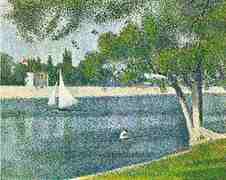
d / Einstein and Seurat: twins separated at birth? Seine Grande Jatte by Georges Seurat (19th century).
Discussion Questions
◊ Suppose someone rebuts the digital camera data in figure a, claiming that the random pattern of dots occurs not because of anything fundamental about the nature of light but simply because the camera's pixels are not all exactly the same --- some are just more sensitive than others. How could we test this interpretation?
◊ Discuss how the correspondence principle applies to the observations and concepts discussed in this section.
13.2.2 How much light is one photon?
The photoelectric effect
We have seen evidence that light energy comes in little chunks, so the next question to be asked is naturally how much energy is in one chunk. The most straightforward experimental avenue for addressing this question is a phenomenon known as the photoelectric effect. The photoelectric effect occurs when a photon strikes the surface of a solid object and knocks out an electron. It occurs continually all around you. It is happening right now at the surface of your skin and on the paper or computer screen from which you are reading these words. It does not ordinarily lead to any observable electrical effect, however, because on the average free electrons are wandering back in just as frequently as they are being ejected. (If an object did somehow lose a significant number of electrons, its growing net positive charge would begin attracting the electrons back more and more strongly.)
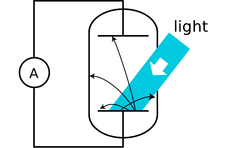
e / Apparatus for observing the photoelectric effect. A beam of light strikes a capacitor plate inside a vacuum tube, and electrons are ejected (black arrows).
Figure e shows a practical method for detecting the photoelectric effect. Two very clean parallel metal plates (the electrodes of a capacitor) are sealed inside a vacuum tube, and only one plate is exposed to light. Because there is a good vacuum between the plates, any ejected electron that happens to be headed in the right direction will almost certainly reach the other capacitor plate without colliding with any air molecules.
The illuminated (bottom) plate is left with a net positive charge, and the unilluminated (top) plate acquires a negative charge from the electrons deposited on it. There is thus an electric field between the plates, and it is because of this field that the electrons' paths are curved, as shown in the diagram. However, since vacuum is a good insulator, any electrons that reach the top plate are prevented from responding to the electrical attraction by jumping back across the gap. Instead they are forced to make their way around the circuit, passing through an ammeter. The ammeter allows a measurement of the strength of the photoelectric effect.
An unexpected dependence on frequency
The photoelectric effect was discovered serendipitously by Heinrich Hertz in 1887, as he was experimenting with radio waves. He was not particularly interested in the phenomenon, but he did notice that the effect was produced strongly by ultraviolet light and more weakly by lower frequencies. Light whose frequency was lower than a certain critical value did not eject any electrons at all. (In fact this was all prior to Thomson's discovery of the electron, so Hertz would not have described the effect in terms of electrons --- we are discussing everything with the benefit of hindsight.) This dependence on frequency didn't make any sense in terms of the classical wave theory of light. A light wave consists of electric and magnetic fields. The stronger the fields, i.e., the greater the wave's amplitude, the greater the forces that would be exerted on electrons that found themselves bathed in the light. It should have been amplitude (brightness) that was relevant, not frequency. The dependence on frequency not only proves that the wave model of light needs modifying, but with the proper interpretation it allows us to determine how much energy is in one photon, and it also leads to a connection between the wave and particle models that we need in order to reconcile them.
To make any progress, we need to consider the physical process by which a photon would eject an electron from the metal electrode. A metal contains electrons that are free to move around. Ordinarily, in the interior of the metal, such an electron feels attractive forces from atoms in every direction around it. The forces cancel out. But if the electron happens to find itself at the surface of the metal, the attraction from the interior side is not balanced out by any attraction from outside. In popping out through the surface the electron therefore loses some amount of energy \(E_s\), which depends on the type of metal used.
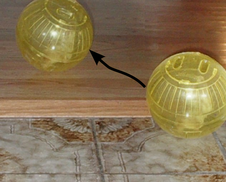
f / The hamster in her hamster ball is like an electron emerging from the metal (tiled kitchen floor) into the surrounding vacuum (wood floor). The wood floor is higher than the tiled floor, so as she rolls up the step, the hamster will lose a certain amount of kinetic energy, analogous to \(E_s\). If her kinetic energy is too small, she won't even make it up the step.
Suppose a photon strikes an electron, annihilating itself and giving up all its energy to the electron. (We now know that this is what always happens in the photoelectric effect, although it had not yet been established in 1905 whether or not the photon was completely annihilated.) The electron will (1) lose kinetic energy through collisions with other electrons as it plows through the metal on its way to the surface; (2) lose an amount of kinetic energy equal to \(E_s\) as it emerges through the surface; and (3) lose more energy on its way across the gap between the plates, due to the electric field between the plates. Even if the electron happens to be right at the surface of the metal when it absorbs the photon, and even if the electric field between the plates has not yet built up very much, \(E_s\) is the bare minimum amount of energy that it must receive from the photon if it is to contribute to a measurable current. The reason for using very clean electrodes is to minimize \(E_s\) and make it have a definite value characteristic of the metal surface, not a mixture of values due to the various types of dirt and crud that are present in tiny amounts on all surfaces in everyday life.
We can now interpret the frequency dependence of the photoelectric effect in a simple way: apparently the amount of energy possessed by a photon is related to its frequency. A low-frequency red or infrared photon has an energy less than \(E_s\), so a beam of them will not produce any current. A high-frequency blue or violet photon, on the other hand, packs enough of a punch to allow an electron to make it to the other plate. At frequencies higher than the minimum, the photoelectric current continues to increase with the frequency of the light because of effects (1) and (3).
Numerical relationship between energy and frequency
Prompted by Einstein's photon paper, Robert Millikan (whom we first encountered in chapter 8) figured out how to use the photoelectric effect to probe precisely the link between frequency and photon energy. Rather than going into the historical details of Millikan's actual experiments (a lengthy experimental program that occupied a large part of his professional career) we will describe a simple version, shown in figure g, that is used sometimes in college laboratory courses.2 The idea is simply to illuminate one plate of the vacuum tube with light of a single wavelength and monitor the voltage difference between the two plates as they charge up. Since the resistance of a voltmeter is very high (much higher than the resistance of an ammeter), we can assume to a good approximation that electrons reaching the top plate are stuck there permanently, so the voltage will keep on increasing for as long as electrons are making it across the vacuum tube.
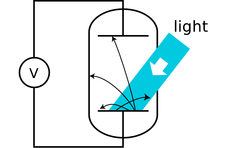
g / A different way of studying the photoelectric effect.
At a moment when the voltage difference has a reached a value \(\Delta \)V, the minimum energy required by an electron to make it out of the bottom plate and across the gap to the other plate is \(E_s+e\Delta \)V. As \(\Delta V\) increases, we eventually reach a point at which \(E_s+e\Delta V\) equals the energy of one photon. No more electrons can cross the gap, and the reading on the voltmeter stops rising. The quantity \(E_s+e\Delta V\) now tells us the energy of one photon. If we determine this energy for a variety of wavelengths, h, we find the following simple relationship between the energy of a photon and the frequency of the light:
\[\begin{equation*} E = hf , \end{equation*}\]
where \(h\) is a constant with the value \(6.63\times10^{-34}\ \text{J}\cdot\text{s}\). Note how the equation brings the wave and particle models of light under the same roof: the left side is the energy of one particle of light, while the right side is the frequency of the same light, interpreted as a wave. The constant \(h\) is known as Planck's constant, for historical reasons explained in the footnote beginning on the preceding page.
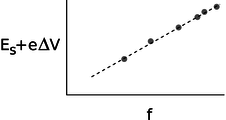
h / The quantity \(E_s+e\Delta V\) indicates the energy of one photon. It is found to be proportional to the frequency of the light.
self-check:
How would you extract \(h\) from the graph in figure h? What if you didn't even know \(E_s\) in advance, and could only graph \(e\Delta V\) versus \(f\)?
(answer in the back of the PDF version of the book)
Since the energy of a photon is \(hf\), a beam of light can only have energies of \(hf\), \(2hf\), \(3hf\), etc. Its energy is quantized --- there is no such thing as a fraction of a photon. Quantum physics gets its name from the fact that it quantizes quantities like energy, momentum, and angular momentum that had previously been thought to be smooth, continuous and infinitely divisible.
| Example 7: Number of photons emitted by a lightbulb per second |
|---|
|
\(\triangleright\) Roughly how many photons are emitted by a 100-W lightbulb in 1 second? \(\triangleright\) People tend to remember wavelengths rather than frequencies for visible light. The bulb emits photons with a range of frequencies and wavelengths, but let's take 600 nm as a typical wavelength for purposes of estimation. The energy of a single photon is \[\begin{align*} E_{photon} &= hf \\ &= hc/\lambda \end{align*}\] A power of 100 W means 100 joules per second, so the number of photons is \[\begin{align*} (100\ \text{J})/E_{photon} &= (100\ \text{J}) / (hc/\lambda ) \\ &\approx 3\times10^{20} \end{align*}\] This hugeness of this number is consistent with the correspondence principle. The experiments that established the classical theory of optics weren't wrong. They were right, within their domain of applicability, in which the number of photons was so large as to be indistinguishable from a continuous beam. |
| Example 8: Measuring the wave |
|---|
|
When surfers are out on the water waiting for their chance to catch a wave, they're interested in both the height of the waves and when the waves are going to arrive. In other words, they observe both the amplitude and phase of the waves, and it doesn't matter to them that the water is granular at the molecular level. The correspondence principle requires that we be able to do the same thing for electromagnetic waves, since the classical theory of electricity and magnetism was all stated and verified experimentally in terms of the fields \(\mathbf{E}\) and \(\mathbf{B}\), which are the amplitude of an electromagnetic wave. The phase is also necessary, since the induction effects predicted by Maxwell's equation would flip their signs depending on whether an oscillating field is on its way up or on its way back down. This is a more demanding application of the correspondence principle than the one in example 7, since amplitudes and phases constitute more detailed information than the over-all intensity of a beam of light. Eyeball measurements can't detect this type of information, since the eye is much bigger than a wavelength, but for example an AM radio receiver can do it with radio waves, since the wavelength for a station at 1000 kHz is about 300 meters, which is much larger than the antenna. The correspondence principle demands that we be able to explain this in terms of the photon theory, and this requires not just that we have a large number of photons emitted by the transmitter per second, as in example 7, but that even by the time they spread out and reach the receiving antenna, there should be many photons overlapping each other within a space of one cubic wavelength. Problem 47 on p. 903 verifies that the number is in fact extremely large. |
| Example 9: Momentum of a photon |
|---|
|
\(\triangleright\) According to the theory of relativity, the momentum of a beam of light is given by \(p=E/c\). Apply this to find the momentum of a single photon in terms of its frequency, and in terms of its wavelength. \(\triangleright\) Combining the equations \(p=E/c\) and \(E=hf\), we find \[\begin{align*} p &= E/c \\ &= \frac{h}{c}f . \end{align*}\] To reexpress this in terms of wavelength, we use \(c=f\lambda \): \[\begin{align*} p &= \frac{h}{c}\cdot\frac{c}{\lambda} \\ &= \frac{h}{\lambda} \end{align*}\] The second form turns out to be simpler. |
Discussion Questions
◊ The photoelectric effect only ever ejects a very tiny percentage of the electrons available near the surface of an object. How well does this agree with the wave model of light, and how well with the particle model? Consider the two different distance scales involved: the wavelength of the light, and the size of an atom, which is on the order of \(10^{-10}\) or \(10^{-9}\) m.
◊ What is the significance of the fact that Planck's constant is numerically very small? How would our everyday experience of light be different if it was not so small?
◊ How would the experiments described above be affected if a single electron was likely to get hit by more than one photon?
◊ Draw some representative trajectories of electrons for \(\Delta V=0\), \(\Delta V\) less than the maximum value, and \(\Delta V\) greater than the maximum value.
◊ Explain based on the photon theory of light why ultraviolet light would be more likely than visible or infrared light to cause cancer by damaging DNA molecules. How does this relate to discussion question C?
◊ Does \(E=hf\) imply that a photon changes its energy when it passes from one transparent material into another substance with a different index of refraction?
13.2.3 Wave-particle duality
How can light be both a particle and a wave? We are now ready to resolve this seeming contradiction. Often in science when something seems paradoxical, it's because we (1) don't define our terms carefully, or (2) don't test our ideas against any specific real-world situation. Let's define particles and waves as follows:
- Waves exhibit superposition, and specifically interference phenomena.
- Particles can only exist in whole numbers, not fractions.
As a real-world check on our philosophizing, there is one particular experiment that works perfectly. We set up a double-slit interference experiment that we know will produce a diffraction pattern if light is an honest-to-goodness wave, but we detect the light with a detector that is capable of sensing individual photons, e.g., a digital camera. To make it possible to pick out individual dots due to individual photons, we must use filters to cut down the intensity of the light to a very low level, just as in the photos by Prof. Page on p. 837. The whole thing is sealed inside a light-tight box. The results are shown in figure i. (In fact, the similar figures in on page 837 are simply cutouts from these figures.)
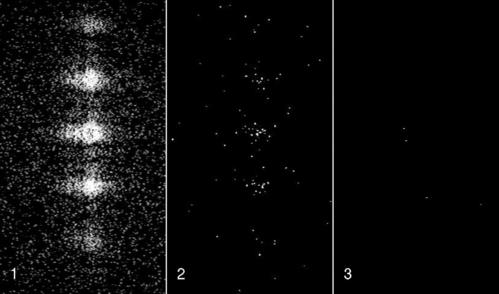
i / Wave interference patterns photographed by Prof. Lyman Page with a digital camera. Laser light with a single well-defined wavelength passed through a series of absorbers to cut down its intensity, then through a set of slits to produce interference, and finally into a digital camera chip. (A triple slit was actually used, but for conceptual simplicity we discuss the results in the main text as if it was a double slit.) In panel 2 the intensity has been reduced relative to 1, and even more so for panel 3.
Neither the pure wave theory nor the pure particle theory can explain the results. If light was only a particle and not a wave, there would be no interference effect. The result of the experiment would be like firing a hail of bullets through a double slit, j. Only two spots directly behind the slits would be hit.
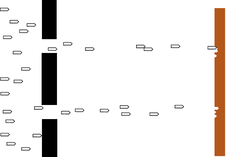
j / Bullets pass through a double slit.
If, on the other hand, light was only a wave and not a particle, we would get the same kind of diffraction pattern that would happen with a water wave, k. There would be no discrete dots in the photo, only a diffraction pattern that shaded smoothly between light and dark.
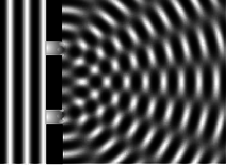
k / A water wave passes through a double slit.
Applying the definitions to this experiment, light must be both a particle and a wave. It is a wave because it exhibits interference effects. At the same time, the fact that the photographs contain discrete dots is a direct demonstration that light refuses to be split into units of less than a single photon. There can only be whole numbers of photons: four photons in figure i/3, for example.
A wrong interpretation: photons interfering with each other
One possible interpretation of wave-particle duality that occurred to physicists early in the game was that perhaps the interference effects came from photons interacting with each other. By analogy, a water wave consists of moving water molecules, and interference of water waves results ultimately from all the mutual pushes and pulls of the molecules. This interpretation was conclusively disproved by G.I. Taylor, a student at Cambridge. The demonstration by Prof. Page that we've just been discussing is essentially a modernized version of Taylor's work. Taylor reasoned that if interference effects came from photons interacting with each other, a bare minimum of two photons would have to be present at the same time to produce interference. By making the light source extremely dim, we can be virtually certain that there are never two photons in the box at the same time. In figure i/3, however, the intensity of the light has been cut down so much by the absorbers that if it was in the open, the average separation between photons would be on the order of a kilometer! At any given moment, the number of photons in the box is most likely to be zero. It is virtually certain that there were never two photons in the box at once.

l / A single photon can go through both slits.
The concept of a photon's path is undefined.
If a single photon can demonstrate double-slit interference, then which slit did it pass through? The unavoidable answer must be that it passes through both! This might not seem so strange if we think of the photon as a wave, but it is highly counterintuitive if we try to visualize it as a particle. The moral is that we should not think in terms of the path of a photon. Like the fully human and fully divine Jesus of Christian theology, a photon is supposed to be 100% wave and 100% particle. If a photon had a well defined path, then it would not demonstrate wave superposition and interference effects, contradicting its wave nature. (In subsection 13.3.4 we will discuss the Heisenberg uncertainty principle, which gives a numerical way of approaching this issue.)
Another wrong interpretation: the pilot wave hypothesis
A second possible explanation of wave-particle duality was taken seriously in the early history of quantum mechanics. What if the photon particle is like a surfer riding on top of its accompanying wave? As the wave travels along, the particle is pushed, or “piloted” by it. Imagining the particle and the wave as two separate entities allows us to avoid the seemingly paradoxical idea that a photon is both at once. The wave happily does its wave tricks, like superposition and interference, and the particle acts like a respectable particle, resolutely refusing to be in two different places at once. If the wave, for instance, undergoes destructive interference, becoming nearly zero in a particular region of space, then the particle simply is not guided into that region.
The problem with the pilot wave interpretation is that the only way it can be experimentally tested or verified is if someone manages to detach the particle from the wave, and show that there really are two entities involved, not just one. Part of the scientific method is that hypotheses are supposed to be experimentally testable. Since nobody has ever managed to separate the wavelike part of a photon from the particle part, the interpretation is not useful or meaningful in a scientific sense.
The probability interpretation
The correct interpretation of wave-particle duality is suggested by the random nature of the experiment we've been discussing: even though every photon wave/particle is prepared and released in the same way, the location at which it is eventually detected by the digital camera is different every time. The idea of the probability interpretation of wave-particle duality is that the location of the photon-particle is random, but the probability that it is in a certain location is higher where the photon-wave's amplitude is greater.
More specifically, the probability distribution of the particle must be proportional to the square of the wave's amplitude,
\[\begin{equation*} (\text{probability distribution}) \propto (\text{amplitude})^2 . \end{equation*}\]
This follows from the correspondence principle and from the fact that a wave's energy density is proportional to the square of its amplitude. If we run the double-slit experiment for a long enough time, the pattern of dots fills in and becomes very smooth as would have been expected in classical physics. To preserve the correspondence between classical and quantum physics, the amount of energy deposited in a given region of the picture over the long run must be proportional to the square of the wave's amplitude. The amount of energy deposited in a certain area depends on the number of photons picked up, which is proportional to the probability of finding any given photon there.
| Example 10: A microwave oven |
|---|
|
\(\triangleright\) The figure shows two-dimensional (top) and one-dimensional (bottom) representations of the standing wave inside a microwave oven. Gray represents zero field, and white and black signify the strongest fields, with white being a field that is in the opposite direction compared to black. Compare the probabilities of detecting a microwave photon at points A, B, and C.
m / Example 10. \(\triangleright\) A and C are both extremes of the wave, so the probabilities of detecting a photon at A and C are equal. It doesn't matter that we have represented C as negative and A as positive, because it is the square of the amplitude that is relevant. The amplitude at B is about 1/2 as much as the others, so the probability of detecting a photon there is about 1/4 as much. |
The probability interpretation was disturbing to physicists who had spent their previous careers working in the deterministic world of classical physics, and ironically the most strenuous objections against it were raised by Einstein, who had invented the photon concept in the first place. The probability interpretation has nevertheless passed every experimental test, and is now as well established as any part of physics.
An aspect of the probability interpretation that has made many people uneasy is that the process of detecting and recording the photon's position seems to have a magical ability to get rid of the wavelike side of the photon's personality and force it to decide for once and for all where it really wants to be. But detection or measurement is after all only a physical process like any other, governed by the same laws of physics. We will postpone a detailed discussion of this issue until p. 864, since a measuring device like a digital camera is made of matter, but we have so far only discussed how quantum mechanics relates to light.
| Example 11: What is the proportionality constant? |
|---|
|
\(\triangleright\) What is the proportionality constant that would make an actual equation out of \((\text{probability distribution})\propto(\text{amplitude})^2\)? \(\triangleright\) The probability that the photon is in a certain small region of volume \(v\) should equal the fraction of the wave's energy that is within that volume. For a sinusoidal wave, which has a single, well-defined frequency \(f\), this gives \[\begin{align*} P &= \frac{\text{energy in volume $v$}}{\text{energy of photon}} \\ &= \frac{\text{energy in volume $v$}}{hf} . \end{align*}\] We assume \(v\) is small enough so that the electric and magnetic fields are nearly constant throughout it. We then have \[\begin{equation*} P = \frac{\left(\frac{1}{8\pi k}|\mathbf{E}|^2 +\frac{c^2}{8\pi k}|\mathbf{B}|^2\right)v}{hf} . \end{equation*}\] We can simplify this formidable looking expression by recognizing that in a plane wave, \(|\mathbf{E}|\) and \(|\mathbf{B}|\) are related by \(|\mathbf{E}|=c|\mathbf{B}|\). This implies (problem 40, p. 725), that the electric and magnetic fields each contribute half the total energy, so we can simplify the result to \[\begin{align*} P &= 2\frac{\left(\frac{1}{8\pi k}|\mathbf{E}|^2\right)v}{hf} \\ &= \frac{v}{4\pi khf}|\mathbf{E}|^2 . \end{align*}\] The probability is proportional to the square of the wave's amplitude, as advertised.3 |
Discussion Questions
◊ Referring back to the example of the carrot in the microwave oven, show that it would be nonsensical to have probability be proportional to the field itself, rather than the square of the field.
◊ Einstein did not try to reconcile the wave and particle theories of light, and did not say much about their apparent inconsistency. Einstein basically visualized a beam of light as a stream of bullets coming from a machine gun. In the photoelectric effect, a photon “bullet” would only hit one atom, just as a real bullet would only hit one person. Suppose someone reading his 1905 paper wanted to interpret it by saying that Einstein's so-called particles of light are simply short wave-trains that only occupy a small region of space. Comparing the wavelength of visible light (a few hundred nm) to the size of an atom (on the order of 0.1 nm), explain why this poses a difficulty for reconciling the particle and wave theories.
◊ Can a white photon exist?
◊ In double-slit diffraction of photons, would you get the same pattern of dots on the digital camera image if you covered one slit? Why should it matter whether you give the photon two choices or only one?
13.2.4 Photons in three dimensions
Up until now I've been sneaky and avoided a full discussion of the three-dimensional aspects of the probability interpretation. The example of the carrot in the microwave oven, for example, reduced to a one-dimensional situation because we were considering three points along the same line and because we were only comparing ratios of probabilities. The purpose of bringing it up now is to head off any feeling that you've been cheated conceptually rather than to prepare you for mathematical problem solving in three dimensions, which would not be appropriate for the level of this course.
A typical example of a probability distribution in section 13.1 was the distribution of heights of human beings. The thing that varied randomly, height, \(h\), had units of meters, and the probability distribution was a graph of a function \(D(h)\). The units of the probability distribution had to be \(\text{m}^{-1}\) (inverse meters) so that areas under the curve, interpreted as probabilities, would be unitless: \((\text{area})=(\text{height})(\text{width})=\text{m}^{-1}\cdot\text{m}\).
Now suppose we have a two-dimensional problem, e.g., the probability distribution for the place on the surface of a digital camera chip where a photon will be detected. The point where it is detected would be described with two variables, \(x\) and \(y\), each having units of meters. The probability distribution will be a function of both variables, \(D(x,y)\). A probability is now visualized as the volume under the surface described by the function \(D(x,y)\), as shown in figure n. The units of \(D\) must be \(\text{m}^{-2}\) so that probabilities will be unitless: \((\text{probability})=(\text{depth})(\text{length})(\text{width}) =\text{m}^{-2}\cdot\text{m}\cdot\text{m}\). In terms of calculus, we have \(P\:=\:\int Ddx dy\).
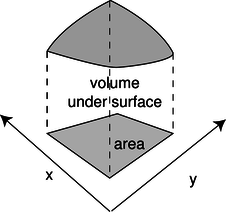
n / Probability is the volume under a surface defined by \(D(x,y)\).
Generalizing finally to three dimensions, we find by analogy that the probability distribution will be a function of all three coordinates, \(D(x,y,z)\), and will have units of \(\text{m}^{-3}\). It is unfortunately impossible to visualize the graph unless you are a mutant with a natural feel for life in four dimensions. If the probability distribution is nearly constant within a certain volume of space \(v\), the probability that the photon is in that volume is simply \(vD\). If not, then we can use an integral, \(P\:=\:\int Ddx dydz\).
Contributors
Benjamin Crowell (Fullerton College). Conceptual Physics is copyrighted with a CC-BY-SA license.



